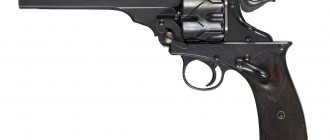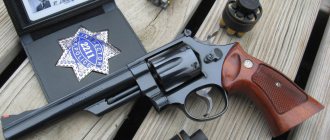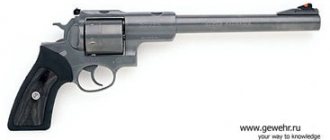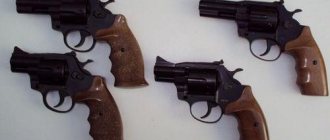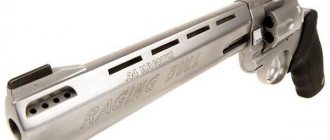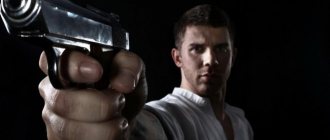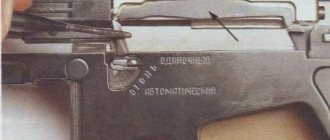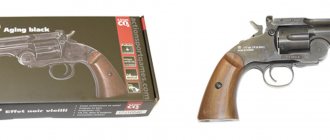Type of automatic revolver
| Matheba Autovolver | |
| Mateba Model 6 Unica (Dynamic Sportiva) | |
| Type | Automatic revolver |
| Place of origin | Italy |
| Production history | |
| Designer | Emilio Ghisoni |
| Developed | 1997 |
| Manufacturer | M.A.TE.B.A. Arms (Macchine Termo-Balistiche), Via Villa Serafina, 2/B. 27100 Pavia (Italy) MATEBA Montebelluna, Italy |
| Produced | 1997—2005, 2018-present |
| Options | Options |
| Characteristics | |
| Weight | 2.96 lb (1.35 kg) |
| Length | 275 mm (10.83 in) |
| Barrel length | 76mm (3"), 102mm (4"), 127mm (5"), 152mm (6"), 178mm (7"), 203mm (8") and 457mm (18") |
| Cartridge |
|
| Action | Recoil operating semi-automatic pistol |
| Rate of fire | Semi-automatic |
| Feeding system | 6 round cylinder |
| Attractions | Iron Sights Night Sight with Fixed Two-Dot Sight |
Mateba Model 6 Unica
(often referred to simply as
the Mateba
or
Mateba Autorevolver
) is a recoil-operated semi-automatic pistol, one of only a few of this type ever created. It was developed by Mateba of Pavia, Italy.
Emilio Ghisoni (d. 2008) is listed as the owner of US Patent 4,712,466, which details the operation of this weapon.
As of March 23, 2022, Mateba in Montebelluna, Italy has reintroduced the 6 Unica and Grifone Carbine. [12]
Matheba only makes Unica in .357 and .44 Mag.
Design[edit]
The Mateba Model 6 uses the recoil of the shot to rotate the cylinder and cock the hammer, unlike conventional revolvers, which rely on the user physically pulling the trigger and/or cocking the hammer to actuate the weapon's action.
The barrel adjustment of the Mateba Autorevolver is different from most other revolvers. The barrel is aligned with the bottom of the cylinder, not the top. This lowers the bore axis (barrel line), which directs recoil according to the shooter's hand position, thereby reducing barrel rotation or flip in conventional revolvers. [3]
The entire upper part of the gun (barrel, cylinder and frame) is mounted on rails on the lower frame, which houses the trigger, hammer and grip, and recoil is 1/2 inch or 12.7 mm when fired. Rearward movement of the upper assembly sets the hammer in motion, and the cylinder rotates in a forward stroke. [4] This unique action makes this revolver a semi-automatic weapon, making it one of very few semi-automatic revolvers, another notable design being the Webley–Fosbery self-cocking automatic revolver. The chambering of the 454 Casull makes it one of the most powerful semi-automatic pistols ever produced, if not the most powerful. This placement puts the Mateba in comparison to firearms such as the Wildey pistol chambered in .475 Wildey Magnum and .44 Mag examples of the AutoMag pistol.
Design
The Mateba Model 6 uses the recoil from firing to rotate the cylinder and cock the hammer, unlike conventional revolvers, which depends on the user physically pulling the trigger and/or cocking the hammer to actuate the weapon's mechanism of operation.
The Mateba Autorevolver's barrel alignment is different from most other revolvers. The barrel is aligned with the bottom of the cylinder instead of the top. This lowers the bore axis (line of the barrel) which directs the recoil in line with the shooter's hand thereby reducing the twisting motion or muzzle flip of normal revolvers.
The gun's entire upper assembly (barrel, cylinder and frame) are mounted on rails on the lower frame, which houses the trigger, hammer, and grip, and recoils 1/2 of an inch, or 12.7mm, on firing. The rearward motion of the upper assembly cocks the hammer, and the cylinder is rotated on the forward stroke. This unique action makes this revolver a semi automatic weapon, making it one of the very few semi automatic revolver designs, another notable design being the Webley–Fosbery Self-Cocking Automatic Revolver. The inclusion of the 454 Casull chambering makes the gun one of, if not the, most powerful semi-automatic handgun ever produced. This chambering places the Mateba in comparison to firearms like the Wildey pistol chambered in .475 Wildey Magnum and .44 Mag examples of the AutoMag pistol.
Options [edit]
The following are variants of the Matheba revolver: [5] [6] [7] [8]
- Protection
- 4" barrel, .357 Magnum - Home Protection
- 5" Barrel, .44 Remington Magnum - Dynamic Sportiva
- 5" or 6" barrel, .357 Magnum - Hunter
- 8 3/8" barrel, .357 Magnum and .44 Remington Magnum (.44 S&W Special)
In addition, their barrels can be replaced with interchangeable barrels of 3, 4, 5, 6, 7 and 8 inches.
Matheba Griffin[edit]
The Mateba Grifone rifle was also available
, which combined an 18-inch barrel, handguard and stock with an Autorevolver frame and action. It was available in .357 Magnum and .44 Magnum calibers. A .454 Casull version was available, which also fired .45 Colt rounds. [9]
International Space Station
Smith & Wesson model 29 magnum .44: the coolest revolver in the world
International Space Station emblem. Image: Mysid / NASA / Wikimedia Commons ALPHA 2022 mission emblem. Image: ASTROnote ISS 2022 55th mission emblem. Image: Tim Gagnon / Jorge Cartes / NASA / Wikimedia Commons
The International Space Station (ISS) is the successor to the Mir station, which was sunk in the Pacific Ocean in 2001. Today, the ISS, launched in 1998, is used for space missions by 14 countries, with astronauts from Russia, the USA, Canada, Japan, and those from the European Space Agency working on board. The main purpose of the station is scientific research.
Ability to use multiple cartridges[edit]
Rear view of the Unica 6 with the cylinder in the open position.
Mateba automatic revolvers chambered in .357 Magnum can be chambered with .38 Special cartridges. Typical .38 Special loads do not have enough power to fully engage the recoil mechanism, but the weapon will still operate with a double-action trigger pull. [3] There are two optional recoil springs designed specifically for .38 Special cartridges that the operator can install to solve this problem (.38 Special and .38 wadcutter). Replacing the spring requires removing the bolt assembly, which is locked by a locking pin held in place by a small set screw in the trigger guard. The barrel shroud acts as a spring stop and guide rod bushing.
Autovolvers chambered in 44 Magnum can have the recoil spring changed to fire 44 Special, and the 454 Casull can fire 45 Long Colt with a spring change.
Multiple cartridge capabilities
Rear view of the Unica 6 with cylinder in open position.
Mateba Autorevolvers chambered in .357 Magnum can be loaded with .38 Special ammunition. Typical .38 Special loads do not have enough power to fully cycle the recoil mechanism, but the weapon will still function with a double-action trigger pull. There are two optional recoil springs designed specifically for .38 Special cartridges that can be installed by the operator to overcome this problem (.38 Special and .38 wadcutter). Replacing the spring requires the removal of the slide assembly, which is blocked by a retaining pin held in place by a small set screw in the triggerguard. The barrel shroud acts as the spring keeper and guide rod bushing.
Autorevolvers chambered in 44 Magnum can have the recoil spring swapped out to shoot 44 special and 454 Casull can fire 45 Long Colt with a spring swap.
Links[edit]
| Wikimedia Commons has media related to Mateba Model 6 Unica . |
- "MATEBA Revolver". www.mateba-italy.com
. - "MATEBA Still Making 6 Unica". www.thefirearmblog.com
. March 23, 2022. - ^ ab Mateba Model 6 Unica. Archived August 23, 2007, at the Wayback Machine. Retrieved August 19, 2008.
- Matheba, the future of revolvers?. Archived October 6, 2008, on the Wayback Machine. Retrieved August 19, 2008.
- MATEBA AutoRevolver 6-Protection. Retrieved August 19, 2008.
- MATEBA AutoRevolver 6-Dynamic Sportiva. Retrieved August 19, 2008.
- MATEBA AutoRevolver 6-Home protection. Retrieved August 19, 2008.
- MATEBA AutoRevolver 6-Hunter. Retrieved August 19, 2008.
- MATEBA Grifone. Retrieved August 19, 2008.
Blockade
The blockade of the fortress began. The Persians hoped that the colonel would surrender due to hunger. For four days the Russians ate grass and horse meat. But supplies have dried up. Yuzbash appeared, providing a service. At night, he got out of the fortress and told Tsitsianov about what was happening in the Russian camp. The alarmed prince, who did not have soldiers or food to help, wrote to Karyagin. He wrote that he believed that Colonel Karyagin’s campaign would end successfully.
Yuzbash returned with a small amount of food. There was only enough food for the day. Yuzbash began to lead the detachment past the Persians at night for food. One day they almost collided with the enemy, but in the darkness of night and fog they set up an ambush. In a couple of seconds, the soldiers killed all the Persians without firing a single shot, only during a bayonet attack.
To hide the traces of this attack, they took horses, sprinkled blood, and hid the corpses in a ravine. And the Persians did not know about the sortie and the death of their patrol. Such sorties allowed Karyagin to hold out for another seven days. But in the end, the Persian prince lost patience and offered the colonel a reward for going over to the Persian side by surrendering Shah-Bulakh. He promised that no one would get hurt. Karyagin suggested 4 days to think, but that all this time the prince would deliver food to the Russians. And he agreed. This was a bright page in the history of Colonel Karyagin’s campaign: the Russians recovered during this time.
And by the end of the fourth day the prince sent messengers. Karyagin replied that the next day the Persians would occupy Shah-Bulakh. He kept his word. At night, the Russians went to the Muhrat fortress, which was convenient to defend.
They walked along circuitous paths through the mountains, avoiding the Persians in the dark. The enemy discovered the Russian deception only in the morning, when Kotlyarevsky with wounded soldiers and officers was already in Mukhrat, and Karyagin with guns crossed the most dangerous areas. And if not for the heroic spirit, any obstacle could have made this impossible.
Encores on the Baltic
In June 1941, the Red Banner Baltic Fleet Air Force included 38 I-15bis fighters. Almost all of the “Encores” of the Baltic Military District died in the first days of the war, the 65th Shap from the Leningrad Military District Air Force was redeployed to the north, so these naval aviation fighters mainly represented this type in the Leningrad area.
During the first period of hostilities, I-15bis were practically not indicated in combat reports. In January 1942, 8 I-15bis became part of the 71st IAP of the 61st Air Brigade. They were based at the Novaya Ladoga airfield, their main task was to cover the route across Lake Ladoga.
At the end of October 1942, the enemy attempted to capture Suho Island on Lake Ladoga. On October 22, I-15bis of the 71st IAP took part in the defeat of the enemy landing. On this day, an air battle between five I-15bis and six Bf 109s took place. One “109” was shot down, but we also lost two aircraft.
As of July 1, 1943, the Baltic Fleet Air Force has eight I-15bis as part of the 25th UAE at the airfield in Berngardovka and three I-15bis of the 7th training air squadron at the White Crosses airfield. In addition, several
The I-15bis was part of the 10th Guards IAP (together with the I-153). The nature of their combat operations consisted of flying out on free hunts along roads, participating in counter-battery warfare, and fighting searchlights.
A real cowboy revolver
Smith & Wesson model 29 magnum .44: the coolest revolver in the world
Another iconic weapon in the second half of the 19th century was the Smith & Vesson first model cartridge revolver, which appeared in 1857. The Smith and Wesson brothers managed to win over Rollin White, the inventor of the through-drum, thereby snatching the palm from Samuel Colt for 18 years. We often see this weapon in American Westerns, and this revolver can truly rightfully be called the cowboy's favorite weapon.
Smith and Wesson model 1
The impressive appearance of this weapon commands respect. The massive body with a long barrel clearly indicated that this was a powerful and formidable weapon. A distance of 50-70 meters was lethal for this revolver. Thanks to the design of the drum and unitary cartridges, the first model of the Smith & Vesson revolver was so successful that the company's shareholders decided to enter the domestic market. The revolver began to be sold privately and soon became the most common personal weapon. Assessing the demand for such weapons, the brothers soon created a new version, Model 3, which already had .44 and .45 calibers. It was truly a cowboy's revolver, which, together with the product of Samuel Colt's Colt Peacemaker SAA, became legends of the Wild West. The new version of the Model 3 American initially sold well in the domestic market, after which an attempt was made to enter the global arms market.
Smith and Wesson model 3
We can talk a lot about this weapon for a long time. Many factors contributed to the success that accompanied American inventors. Firstly, such weapons came to the court of the American army, which at that time was going through a difficult path of rearmament and re-equipment. Secondly, the economic and migration policies that were observed in the United States in the second half of the 19th century forced the discoverers of vast undeveloped spaces to look for effective means of armed struggle. In this regard, a revolver was an ideal weapon that could solve personal tactical problems.
Colt Open Top Pocket.
Open Top Pocket Revolver - a similar design, which appeared in 1871, was an anachronism even for its time, but this seven-shot open frame .22 caliber rimfire revolver became very popular and was mentioned in the company's commercial catalogs until until the 1880s. In total, about 114,000 copies of this model were sold. The revolver frame was made of brass, the drum had a smooth surface, and the handle was made in the shape of a bird's head. The trigger, according to the fashion of those years, was hidden in the protrusion of the frame. The ejector ramrod, placed on the right side of the barrel, was available only on early samples; starting around 1874, manufacturers abandoned it. In revolvers manufactured after 1874, the cylinder had to be removed from the frame to remove spent cartridges. It was also possible to equip an empty drum with cartridges through a recess in the frame shield on the right side.
Sports and records
Cowboy shooting
Cowboy shooting In the USA, since the early 1980s, cowboy shooting competitions, which are also a costumed theatrical show, have been popular. In these competitions, weapons from the era of the development of the Wild West are used, in particular, short-barreled weapons - exclusively single-action revolvers.
Fast draw
Fast Shooting “Fast draw” is a special sporting discipline that dates back to the romanticized traditions of the Wild West. It reproduces the situation of a sudden firefight: the shooter must take the weapon out of the holster in the minimum amount of time, cock the hammer and aim from the hip one or more times, depending on the conditions of the competition. Single-action revolvers loaded with wax bullets or special blank cartridges are used. The targets are metal shields or balloons. There is a World Fast Draw Association (WFDA).
Records
- American shooter Jerry Miculek set the following high-speed shooting records from a self-cocking revolver: 60 shots (6 out of ten revolvers) in 17.12 s
- 12 shots from a 6-round revolver with a reload time of 2.99 s
- 8 aimed shots from an 8-round revolver at one target in 1.00 s
- 8 aimed shots from an 8-round revolver, two at each of four targets in 1.06 s
- 5 aimed shots at one target in 0.57 s. In this category, the record belongs to Ed McGivern, who in 1932 fired 5 shots in no more than 0.45 seconds, and repeated this result no less than five times.
American Bob Munden (1942-2012), nicknamed “The World's fastest gun,” was able to remove a non-self-cocking revolver from a holster, shoot and holster the weapon in less than 0.2 seconds. Munden became famous for other tricks in shooting with a revolver and rifle.
Notes
Traumatic revolver Nagan-RF
Comments
- Many pistols have a safety design that ensures the first shot is self-cocking, and are designed to be carried with a cartridge in the chamber (for example, Walther PP, Browning Hi-Power, etc.), see also the “Safety” paragraph)
Sources
- REVOLVER // Great Russian Encyclopedia / Chief Editor and Chairman of the Scientific Editorial Council Yu. S. Osipov. - Moscow, 2015. - T. 28. - P. 295. - ISBN 978-5-85270-365-1.
- V. M. Temnov, 2003, p. 195.
- S. L. Fedoseev, 2014, p. 8.
- A.E. Hartink, 1997, p. 15.
- A. B. Zhuk, 1992, p. 8.
- F.K. Babak, 2004, p. 4-5.
- V.I. Murakhovsky, 1992, p. 9.
- Popenker, Maxim R.
Pistols and Revolvers. World.Guns.ru. Archived from the original on February 13, 2012. - Modern small arms - Webley-Fosbery automatic revolver
- Dardick ground Picture of Model 1500 pistol
- ↑ 1 2 Zhuk A. B.
Encyclopedia of small arms. - M.: Military Publishing House, 1998., p. 199, 207 - 20 & 30 shot BP cartridge revolvers you won't believe.
- Very Rare 30 Shot Revolver.
- The triple barrel, 18-shot Pistola con Caricato revolver
- Small arms exhibition in Koblenz (Part 1)
- Dual cylinder revolver. US 5220115 A
- Flayderman's Guide to Antique American Firearms and Their Values. — F+W Media, Inc, 2007, p. 514
- Enouy's percussion revolver
- Joseph Enouy's 8-cylinder, 48-shot percussion revolver, dated 1855
- Col. Le Mat — Jean François Alexander Le Mat
- ↑ 1 2 Fedoseev S.
Weapons of last resort.//Around the World, No. 8, 2010 - Dolne, N.
- Chris Eger.
The Petit Protector Ring Guns: The ultimate ring pops - TURBIAUX Jacques Edmond (Protector)
- Minneapolis Protector Palm Pistol
- Zhuk A. B.
Encyclopedia of small arms. - M.: Military Publishing House, 1998., p. 46 - Antonio García Reynoso mucho más que el nombre de un revolver (Spanish)
- SwissMiniGun
- Pfeifer-Zeliska .600 Nitro Express Magnum
- Worlds Largest and Most Powerful Handgun
- The largest revolver
- Tak strzela największy na świecie rewolwer
- V. Kryuchin. Cowboy shooting.//Kalashnikov, No. 6, 2006
- World Fast Draw Association
- Welcome to Jerry Miculek.com – Titles & Records
- Guinness Book of World Records 1980. - P. 625.
- Bob Munden Fastest Gunslinger ever Unbelievable on YouTube
Common reasons for banning foreign travel
The procedure for traveling outside the Russian Federation is regulated by Federal Law No. 114 of August 15, 1996. Employees of the Ministry of Foreign Affairs, as well as the FSB and the Ministry of Internal Affairs are additionally guided by Order of the Ministry of Foreign Affairs of the Russian Federation No. 8722/996/562/350 of November 17, 2008, which contains a list of conditions under which visits to the territories of foreign states are permitted.
In accordance with current legislation, the following categories of citizens are considered prohibited from traveling:
- FSB officers. They can travel abroad on business. To travel as a tourist, you must obtain permission from the department's leadership in accordance with official instructions.
- Persons with access to state secrets. The restriction can be lifted only after a certain time has elapsed from the date of dismissal.
- Citizens undergoing military or alternative conscription service. Contract soldiers can leave Russia with the permission of the command of the military unit.
- Criminals sentenced to imprisonment, as well as those released on parole or serving a suspended sentence. Permission to leave can only be obtained after expunging a criminal record.
- Persons whom investigative authorities suspect or accuse of committing crimes.
- Citizens who evade execution of court decisions. These are mainly defaulters on loans, alimony and other financial obligations, whose debt amount has reached 30,000 rubles or more.
- Persons who provided false information when preparing documents.
The FSB Border Service monitors compliance with the bans. This topic is discussed in more detail in the article “Ban on traveling abroad.”
Squad position
Karyagin had no hope of any help. By the third day, June 26, the Persians blocked Russian access to water by placing falconette batteries nearby. They were engaged in round-the-clock shelling. And then the losses began to mount. Karyagin himself was shell-shocked three times in the chest and head, and he had a wound right through his side.
Most of the officers left. There were about 150 soldiers left capable of fighting. They all suffered from thirst and heat. The night time was anxious and sleepless. But Colonel Karyagin’s feat began here. The Russians showed particular persistence: they found the strength to make attacks on the Persians.
One day they managed to reach the Persian camp and capture 4 batteries, get water and bring 15 falconets. This was done by a group under the command of Ladinsky. Records have been preserved in which he admired the courage of his soldiers. The success of the operation exceeded the colonel's wildest expectations. He came out to them and kissed the soldiers in front of the entire detachment. Unfortunately, Ladinsky was seriously wounded in the camp the next day.
Tom Hiddleston – historian
Another example of a prestigious English education is Tom Hiddleston, a British actor who is a graduate of the Dragon School in Oxford and the prestigious Eton College.
It is not difficult to guess that the point in academic education was one of the leading universities in the country - Cambridge. Having chosen the Faculty of Classics, the future actor settled on the field of study - “ancient history”. Specializing in Ancient World culture, Tom speaks Latin, Ancient Greek, as well as several "modern" languages - French, Spanish, German and Russian.
